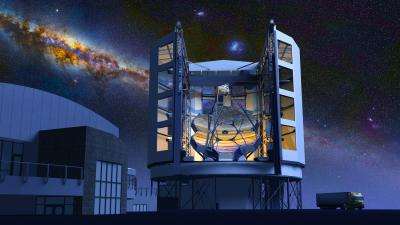Oct 24 2012
Scientists at the University of Arizona and in California have completed the most challenging large astronomical mirror ever made.
 This shows the Giant Magellan Telescope, against the southern Milky Way, as it will appear when it's completed. Credit: Todd Mason/Mason Productions and GMTO Inc.
This shows the Giant Magellan Telescope, against the southern Milky Way, as it will appear when it's completed. Credit: Todd Mason/Mason Productions and GMTO Inc.
For the past several years, a group of optical scientists and engineers working at the UA Steward Observatory Mirror Laboratory underneath the UA's football stadium have been polishing an 8.4-meter (27 ½ feet) diameter mirror with an unusual, highly asymmetric shape.
By the standards used by optical scientists, the "degree of difficulty" for this mirror is 10 times that of any previous large telescope mirror. The mirror surface matches the desired prescription to a precision of 19 nanometers – so smooth that if it were the size of the continental U.S., the highest mountains would be little more than a half-inch high.
This mirror, and six more like it, will form the heart of the 25-meter Giant Magellan Telescope (GMT), providing more than 380 square meters, or 4,000 square feet, of light-collecting area. The Giant Magellan Telescope will lead a next generation of giant telescopes that will explore planets around other stars and the formation of stars, galaxies and black holes in the early universe.
Buell Jannuzi, director of the UA Steward Observatory and professor of astronomy, said, "Making this first GMT mirror required all the expertise and experience that the University has built up over 25 years of making telescope mirrors and a great deal of innovation to push beyond previous limits in optical fabrication and testing. In achieving this remarkable milestone, the team built and demonstrated all the equipment and techniques that will lead to efficient production of the remaining mirrors for the GMT."
The mirror was cast at the mirror lab from 20 tons of glass, melted in a rotating furnace until it flowed into a honeycomb mold. Once the glass had cooled and the mold material was removed, scientists at the lab used a series of fine abrasives to polish the mirror, checking its figure regularly using a number of precision optical tests.
The mirror has an unconventional shape because it is part of what ultimately will be a single 25-meter (82 feet) optical surface composed of seven circular segments, each 8.4 meters (27 ½ feet) in diameter.
"We need to be certain the off-axis shape of this mirror, as well as the other six that will be made for GMT, is precisely right, to an accuracy of 1/20 of a wavelength of light," said Buddy Martin, polishing scientist at the Mirror Lab. "Only then will the seven large mirrors form a single, exquisitely sharp image when they all come together in the telescope in Chile. We have now demonstrated that we can fabricate the mirrors to the required accuracy for the telescope to work as designed."
The testing techniques, developed by Jim Burge, professor at the UA College of Optical Sciences, and his team, are a key part of the innovation enabling these giant off-axis mirrors. The second of seven mirrors for the GMT was cast at the mirror lab in January of this year; the third will be cast in August 2013.
The Giant Magellan Telescope will be located on a remote mountaintop in the Chilean Andes where the skies are clear and dark, far from any sources of light pollution. At the Carnegie Institution for Science's Las Campanas Observatory in northern Chile, earthmovers are completing the removal of 4 million cubic feet of rock to produce a flat platform for the telescope and its supporting buildings.
Wendy Freedman, chair of the GMT board, said: "The technical achievements at the UA's mirror lab and the dedication and commitment of our national and international partners will allow us to open a new window on the universe. An exciting future of discovery awaits us."
The telescope, slated to begin operations late in the decade, will allow astronomers and students across the U.S. and from around the world to address critical questions in cosmology, astrophysics and planetary science.
Matthew Colless, director of the Australian Astronomical Observatory, said, "The Giant Magellan Telescope has the potential to transform how we see the cosmos, and our place in it."